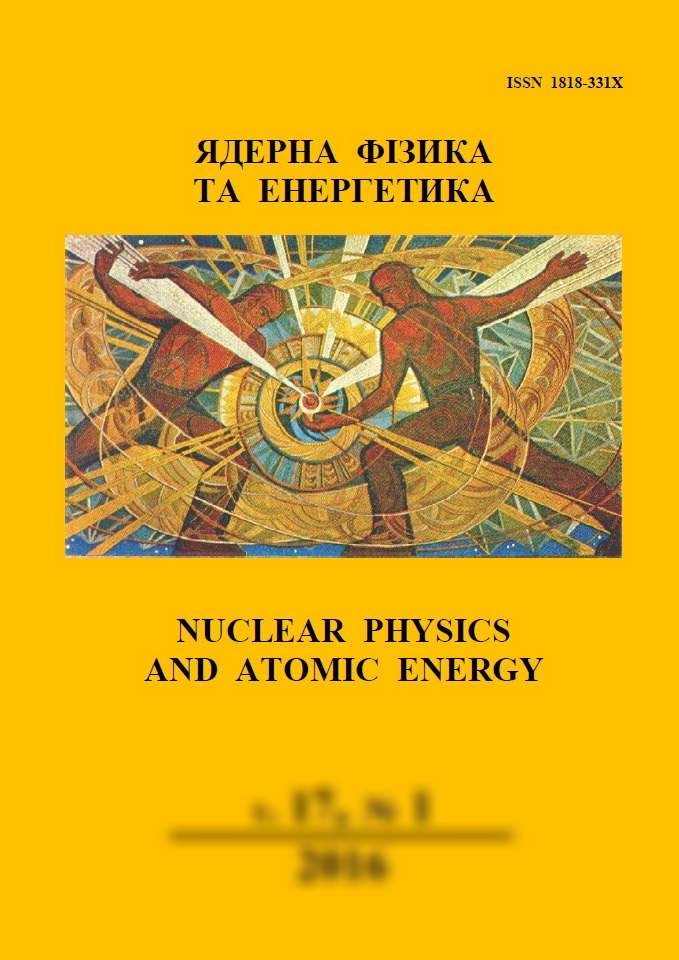 |
Ядерна фізика та енергетика
Nuclear Physics and Atomic Energy
ISSN:
1818-331X (Print), 2074-0565 (Online)
Publisher:
Institute for Nuclear Research of the National Academy of Sciences of Ukraine
Languages:
Ukrainian, English
Periodicity:
4 times per year
Open access peer reviewed journal
|
Nucl. Phys. At. Energy 2023, volume 24, issue 2, pages 162-169.
Section: Engineering and Methods of Experiment.
Received: 06.01.2023; Accepted: 09.05.2023; Published online: 19.06.2023.
 Full text (ua)
Full text (ua)
https://doi.org/10.15407/jnpae2023.02.162
Determination of the deactivating properties of shampoos for cesium, strontium and cobalt
V. V. Levenets1, O. Yu. Lonin1,*, O. P. Omelnik1, A. O. Shchur1, G. V. Prostantinov2
1 National Science Center "Kharkiv Institute of Physics & Technology", Kharkiv, Ukraine
2 Limited Liability Company "Levewell Group", Kyiv, Ukraine
*Corresponding author. E-mail address:
a_lonin@kipt.kharkov.ua
Abstract:
The decontamination properties of shampoos for cesium, strontium, and cobalt were determined. The method has been developed for determining the decontaminating properties of shampoos. The chemical part of the study includes the preparation of hair, which consists of forced pollution and subsequent washing. Stable isotopes were used in the work. This has increased the safety of staff during chemical hair research. The analytical part includes the quantitative determination of the cesium, strontium, and cobalt in the hair, which was carried out by the Particle-Induced X-ray Emission (PIXE) method using the analytical nuclear-physical complex "Sokol". Various shampoos were analyzed, and their decontamination properties were determined. During the research, various samples of shampoos, which are presented on the market of Ukraine, were considered. It has been established that TM "Ringo" shampoo has the best deactivating properties for cesium (Kd - 574.0) and insignificant deactivating properties for strontium (Kd - 3.1) and cobalt (Kd - 3.6). It was determined that with multi-isotope contamination (a mixture of cesium, strontium, and cobalt isotopes) decrease in the deactivation coefficient for all isotopes was observed, which is due to the competition factor of the isotopes in the complexation process with shampoo. Reduction of decontaminating properties was observed on all samples of shampoos.
Keywords:
decontamination properties, deactivation coefficient, cesium, strontium, cobalt, PIXE method.
References:
1. G.V. Hordyuk et al. Deactivating shampoo. Patent UA No. 31190. Published on June 15, 2001, Bull. No. 5/2001. (Ukr)
2. A.A. Shokur. Universal deactivating shampoo. Patent UA No. 26693. Published on October 10, 2007, Bull. No. 16/2007. (Ukr)
3. Methods and means of decontamination of surfaces, food and water. Research and production enterprise “MR QUANT”. (Rus)
http://www.mrkvant.com.ua/radiation/12/
4. Generic Procedures for Assessment and Response During a Radiological Emergency. IAEA-TECDOC-1162 (Vienna, IAEA, 2000) 194 p.
https://www-pub.iaea.org/MTCD/Publications/PDF/te_1162_prn.pdf
5. Nuclear Radiation Decontamination Solutions for Emergency & First Responders.
https://raddecon.com/
6. R.H.S. Winterton. Van der Waals forces. Contemporary Physics 11(6) (2006) 559.
https://doi.org/10.1080/00107517008202194
7. G. Audi et al. The Nubase2016 evaluation of nuclear properties. Chinese Physics C 41(3) (2017) 030001.
https://doi.org/10.1088/1674-1137/41/3/030001
8. A.Yu. Lonin et al. The usage of zeolites for dynamic sorption of cesium from waste waters of nuclear power plants. J. Radioanal. Nucl. Chem. 303(1) (2015) 831.
https://doi.org/10.1007/s10967-014-3597-9
9. Decontamination Approaches During Outage in Nuclear Power Plants - Experiences and Lessons Learned. IAEA-TECDOC-1946 (Vienna, IAEA, 2021) 94 p.
https://www-pub.iaea.org/MTCD/Publications/PDF/TE-1946web.pdf
10. Medical Management of Persons Internally Contaminated with Radionuclides in a Nuclear or Radiological Emergency. A Manual for Medical Personnel (Vienna: IAEA, 2021) 116 p.
https://www-pub.iaea.org/MTCD/Publications/PDF/EPR-Contamination_web.pdf
11. V.G. Baryakhtar. Chornobyl Disaster (Kyiv: Naukova Dumka, 1995) 559 p. (Rus)
12 L.I. Rudenko et al. Purification of liquid radioactive waste from organic compounds using titanium-iron coagulants. Energotekhnologii i Resursosberezheniye 4 (2013) 59. (Rus)
Paper
